최고의 통합 티켓 관리 시스템을 위한 종합 가이드
최종 업데이트: 2023년 11월 20일
티켓 관리 시스템을 제대로 갖추면 의사소통을 하나로 통합할 수 있습니다. 이는 고객 문의, 우선 순위, 보고자에 대한 정보가 부재할 때 발생하는 병목 현상을 제거함으로써 가능해집니다.
하지만 아무리 뛰어난 소프트웨어라도 적절한 인력과 프로세스가 뒷받침되지 않으면 원활하게 작동하지 않습니다.
올바른 실시간 채팅 소프트웨어를 선택하는 방법에 대해 알아보기 전에 통합 티켓 관리 시스템을 살펴보겠습니다. 그럼 다음 성공 사례를 살펴보고, 그 중에서 탑15 통합 티켓 관리 시스템을 소개합니다.
특정 섹션으로 넘어가고 싶은 경우, 아래의 목차를 클릭하여 해당 섹션으로 이동하세요.
- 통합 티켓 관리 시스템이란?
- IT 통합 티켓 관리 시스템의 작동 원리
- 통합 티켓 관리 도구의 기능
- 헬프 데스크 통합 티켓 관리 시스템의 이점
- 통합 티켓 관리 소프트웨어 성공 사례
- 헬프 데스크 통합 티켓 관리 소프트웨어 구현 방법
- 탑15 통합 티켓 관리 시스템
- 상위 15개 통합 티켓 관리 도구 비교 차트
- 가장 적합한 실시간 채팅 웹사이트 소프트웨어를 선택하는 방법
- 온라인 통합 티켓 관리 시스템을 무료로 체험해 보세요
통합 티켓 관리 시스템이란?
통합 티켓 관리 시스템은 고객지원팀이 고객 문의 목록을 생성, 관리, 유지하는 작업에 사용하는 소프트웨어 프로그램입니다.
물론, 대다수 통합 티켓 관리 시스템은 아래와 같은 기능을 제공합니다.
통합 티켓 관리 시스템은 통합 티켓 관리 소프트웨어, 통합 티켓 지원 또는 헬프 데스크 통합 티켓 관리 시스템이라고도 합니다.
기업에 헬프 데스크 통합 티켓 관리 시스템이 필요한 이유는?
고객 지원 요청을 체계화하고, 우선순위를 정하고, 통합하려면 헬프 데스크 통합 티켓 관리가 필요합니다. 통합 티켓 관리 시스템을 갖추면 고객의 문의 내용에 가장 적임인 상담사에게 작업을 할당하고 고객과의 상호작용에 전후상황을 제공하며, 고객 문의를 추적할 수 있습니다. 그 외에도 고객지원팀의 업무 조율에 도움이 되는 공유 메일함을 제공합니다.

IT 통합 티켓 관리 시스템의 작동 원리
IT 헬프 데스크 티켓 통합 관리는 서로 다른 출처에서 수집된 최종 사용자 문의를 티켓으로 변환하고, 고객지원팀이 문의를 해결해 나가는 과정에서 각 티켓의 상태를 추적합니다. 티켓에는 사용자와의 모든 상호작용과 해당 문의에 대한 직원 간의 대화 내역이 기록됩니다.
Zendesk의 IT 통합 티켓 관리 플랫폼을 사용하면 티켓을 문의, 문제, 사고, 작업으로 기록할 수 있습니다. 하나의 문제는 여러 사고를 야기하는 근본 원인이 될 수 있습니다. 가령 회사의 이메일 서버가 다운되면, 이로 인해 여러 사고가 발생할 수 있는데, 근본적인 문제를 해결된 상태로 표시하면 각 사용자의 사고 티켓이 새로운 상태로 업데이트됩니다.
고객 지원 상담사가 티켓을 마무리한다고 해서 티켓이 그냥 사라지는 것이 아닙니다. 티켓에는 고객과 회사에 대한 인사이트를 제공하는 귀중한 데이터가 포함되어 있습니다. IT 통합 티켓 관리 프로그램은 다양한 방식으로 데이터를 나누어 성과 지표를 표시하고 보고서를 생성합니다.

통합 티켓 관리 도구의 기능
최고의 IT 통합 티켓 관리 도구가 설정 및 사용이 편리한 기능을 제공합니다. 단, 해당 기능은 난이도 면에서 상당히 다양할 수 있음을 유의해야 합니다.
지금부터 다양한 온라인 통합 티켓 관리 시스템을 비교하기 위해 평가해야 할 여섯 가지 일반적 기능을 소개합니다.
- 옴니채널 지원
고객은 이메일, 소셜 미디어, 실시간 채팅, 전화 통화 같은 다양한 채널을 통해 고객 센터에 동시에 연락할 수 있습니다. 대다수 기업에서는 이러한 상호작용을 통해 얻은 인사이트가 여러 툴과 부서 간에 분산되어 있어 고객은 연락할 때마다 매번 같은 내용을 반복해야 합니다. 하지만 고객 프로필과 대화 내역을 공유 메일함에 통합하면, 옴니채널 지원을 통해 상담사는 고객이 선호하는 채널에서 응대할 수 있습니다. - 티켓 라우팅, 카테고리 분류, 태그 지정
대기업의 경우, 고객 지원 소통을 하나로 통합하는 것만으로는 충분하지 않습니다. 최상의 서비스를 제공하기 위해서는 상담사가 티켓의 상태, 그리고 다른 상담사에게 티켓을 라우팅하는지 또는 직접 처리하는지를 비롯해 어떤 조치를 취해야 할지 한눈에 파악할 수 있어야 합니다.
이를 위해 헬프 데스크 통합 티켓 관리 시스템은 사용자가 들어오는 티켓을 분류하고 태그를 지정할 수 있게 합니다.
이러한 분류와 태그 지정 기능은 서로 분리되어 있는 대규모 팀에게 티켓을 처리할 스킬과 지식을 갖춘 상담사에게 신속하게 라우팅할 수 있는 능력을 부여합니다. - 추적 · 측정
우수한 고객 서비스 부서는 문의를 신속하게 해결하고 우왕자왕하는 상황을 최소화합니다. 하지만 이 역시 분석 기능 없이는 불가능합니다. 헬프 데스크 통합 티켓 관리 시스템 분석을 사용하면 파악하고자 하는 내용을 기반으로 보고서를 생성할 수 있습니다. 예를 들어, 지원 팀이 특정 문의에 소비하는 시간을 수량화하여 추가 리소스를 어디에 투자할지 결정하는 데 도움이 될 수 있습니다. - 연동 서비스
고객이 다양한 채널을 즐겨 사용하는 것과 마찬가지로 기업도 중요 고객 데이터를 사용하고 관리하기 위해 서로 다른 데이터베이스와 도구를 사용하는 경향이 있는데, 이 결과 사일로가 발생합니다. (Zendesk)를 비롯해 통합 티켓 관리 시스템은 폭넓은 연동 서비스를 통해 사일로를 해소하는 데 효과적입니다.
이 결과, 한결 손쉽게 간소화된 단일 고객 경험을 구축할 수 있습니다. 그리고 성급한 고객을 상대하면서 서로 다른 출처에서 나온 각기 다른 버전의 정보를 파악하느라 어려움을 겪는 상담사의 고충을 덜어줄 수 있습니다. - 지식창고 관리
실시간 채팅과 전화 통화는 올바른 정보를 제공한다는 점에서 여전히 제 역할을 하지만, 많은 고객은 충분히 직접 원하는 정보를 찾을 수 있고 실제로 이러한 방식을 더 선호합니다. 지식창고 시스템은 대량의 정보를 요약해 검색 가능하고 링크로 연결된 데이터베이스에 저장하여 고객이 직접 정보를 찾을 수 있습니다.
이러한 시스템은 고객의 셀프 서비스를 개선하는 동시에 상담사의 티켓 양을 줄여 티켓 지원 체계를 향상시킵니다. 이뿐만 아니라, 지식창고는 상담사들이 고객을 위한 리소스를 손쉽게 찾을 수 있는 검색 데이터베이스를 제공합니다. - 자동화
고객 서비스는 올바른 정보를 적시에 적절한 대상에게 제공하는 것이 '관건'입니다. 심지어 소규모 업체에서도 여러 다른 시스템에서 사람들에게 정보를 전달하는 작업이 상당히 복잡할 수 있습니다. 따라서 티켓 할당, 사전 설정된 응답 전송, 고객 문의 에스컬레이션, 관련 고객 데이터 가져오기 등과 같은 작업을 자동화하면 엄청난 효과를 얻을 수 있습니다.
자동화를 통해 상담사가 단순 반복 업무에 소비하는 시간을 없애거나 줄일 수 있어 상담사의 만족도, 참여도 및 생산성이 높아집니다. 또한 단순 반복 업무를 자동화하면 실수 확률도 줄어듭니다. - 인력 관리 도구
고객 서비스가 성공하려면 상담사와 고객 간의 일대일 상호 작용 외에 더 많은 것이 필요합니다. 그러한 귀중한 상호 작용을 촉진하는 막후의 의사 결정 또한 중요합니다. 통합 티켓 관리 도구와 인력 관리 기능을 함께 사용해 계절에 따라 서비스 운영 직원 배치를 정확하게 계획하고 실시간으로 조정할 수 있습니다.
특히, 이메일, 통화 및 메시지 볼륨을 예측하여 직원의 업무량을 적절하게 관리할 수 있습니다. 결과는 어땠을까요? 비용 효율성이 극대화된 서비스 운영.
헬프 데스크 통합 티켓 관리 시스템의 이점
IT 통합 티켓 관리 소프트웨어는 들어오는 티켓을 접수, 기록, 분류해 문제 해결을 간소화합니다. 간단한 통합 티켓 관리 소프트웨어는 단 한 사람으로 구성된 팀을 비롯해 모든 전문 고객서비스팀을 위한 기본 사항입니다. 아래에서 통합 티켓 관리 소프트웨어의 다섯 가지 강점을 확인해 보세요.
- 상담사 생산성 향상
우수한 고객 서비스는 없어서는 안 될 자산입니다. 하지만 우수 고객 서비스를 제공하는 데에는 정보 검색, 통화 라우팅, 티켓 분류 등 시간이 많이 걸리는 단순 작업이 상당 부분을 차지합니다.
통합 티켓 관리 도구를 통해 이러한 작업의 전부나 일부를 자동화하여 상담사가 교육 및 고객 응대와 같은 중요한 작업에 더 많은 시간을 할애할 수 있습니다. 아울러 상담사의 생산성이 향상되면 조직은 적은 수의 상담사로 더 나은 서비스를 제공할 수 있어 서비스 품질에 영향을 미치지 않고도 비용을 크게 절감할 수 있습니다. - 고객 상호작용의 수준 향상
모든 대화에 대한 완전한 추적 기능을 갖춰 여러 채널에서 대화가 진행되더라도 상담사가 고객과 더 생산적으로 정보에 바탕을 둔 대화를 나눌 수 있습니다.
고객은 같은 내용을 반복할 필요가 없기 때문에 짜증을 덜 느끼고, 상담사는 개인화된 서비스를 제공해 서비스 수준을 한 단계 더 높일 수 있습니다. 예를 들어, 소매업체의 상담사는 고객의 과거 구매 내역을 조회해 사이즈를 확인하고 올바른 청바지 핏을 선택하는 데 도움을 줄 수 있습니다. - 투명한 고객 서비스 성과
티켓 지원 시스템이 없으면 고객 서비스 성과를 평가하는 데 필요한 단일 데이터 소스가 부재합니다. 물론 고객 유지 데이터가 있으면 되지만, 이는 다른 요인의 영향을 받을 수 있습니다. 물론 고객을 대상으로 서비스 품질에 대해 적극적으로 설문조사할 수 있지만, 고객 서비스 성과를 제대로 모니터링하고 평가하려면 더 세분화되고 정량적인 데이터가 필요합니다. - 장기적인 교육과 발전
고객 문의와 상담사의 응답을 한곳에 통합하면, 통합 티켓 관리 시스템은 교육 도구의 역할까지 해냅니다. 관리자는 이를 사용해 새로운 지식창고 문서를 통해 어떤 일반 문의를 더 잘 해결할 수 있는지 알 수 있습니다. 또는 상담사가 대처하는 데 어려움을 겪는 특정 상황을 파악할 수 있고, 이를 통해 추가 교육이 필요한 부분을 파악할 수 있습니다. 시간과 함께 배우고 성장할 수 있는 기회가 많아지면서 우수한 헬프데스크 티켓팅 소프트웨어가 이를 가능하게 합니다. - 사내 부서 간 협업 개선
누구나 잘 알고 있듯이 난감한 전화 문의보다 더 나쁜 고객 서비스 경험은 거의 없습니다. 이러한 상황은 전화로 걸려온 고객 문의를 해결하지 못해 여러 상담사가 통화를 넘길 때 발생합니다. 이러한 문제의 근본 원인은 바로 열악한 사내 의사소통으로, 통합 티켓 관리시스템으로 문제를 줄이거나 제거할 수 있습니다.
통합 티켓 관리 소프트웨어 성공 사례
통합 티켓 관리 소프트웨어에는 놀랄 만한 기능이 많지만, 아무리 최고의 소프트웨어라도 적절한 프로세스를 구축하지 않으면 제대로 실행되지 않습니다. 다음은 고객 서비스 팀이 소프트웨어 투자를 극대화할 수 있는 네 가지 성공 사례입니다.
상담사에게 새로운 시스템 교육 실시
기업은 소프트웨어를 구입하면 모든 기능 중 지극히 일부만 사용하는 경우가 많은데, 통합 티켓 관리 시스템도 예외는 아닙니다. 이러한 문제를 방지하려면 직원들이 시스템을 숙지하도록 교육 프로그램을 실시해야 합니다. 사용하는 통합 티켓 관리 소프트웨어에 따라 공급업체에서 자체 교육을 제공하는데, 이는 관리 부담 없이 직원을 교육할 수 있는 좋은 방법입니다. 그리고 나중에 상담사들은 배운 내용을 바탕으로 신입사원을 교육시킬 수 있습니다.
셀프 서비스 지식창고 구축
고객을 대상으로 한 지식창고를 구축한다는 아이디어는 언뜻 부담스럽게 들릴 수 있지만, 소규모로 시작해 가장 단순하고 일반적인 문제 해결에 도움이 되는 리소스를 제공하는 데 집중하는 것이 좋습니다. 간단한 지식창고만으로도 상담사의 효율성을 높이고 고객을 만족시킬 수 있을 뿐 아니라 제대로 운영된다면 고객이 자주 묻는 질문에 자동으로 답변을 제공할 수도 있습니다.
명확하고 체계적인 태그 지정 시스템 구축 (및 사용)
태그 기능이 없다면 최고의 통합 티켓 관리 시스템을 가장 가치 있게 해주는 것이 빠지게 됩니다. 하지만 태그를 몇 개 만드는 것으로는 충분하지 않습니다. 상담사가 각 티켓의 우선순위를 적절하게 지정하고 라우팅할 수 있도록 어떤 태그가 문제의 전후상황을 적절하게 반영하는지 신중하게 고려해야 합니다.
이뿐만 아니라, 고객 지원 상담사가 고객을 응대하는 과정에서 새로운 정보를 얻는다면, 해당 티켓을 적극적으로 태그 지정해야 합니다. 이러한 방식으로 태그를 지정하면 관련 보고서에 티켓이 표시되며 쉽게 검색할 수 있습니다.
사전 정의된 티켓 작업으로 자동화 구현
자사가 고객 참여 문제를 매우 신속하게 처리하고 있다고 믿고 있는 기업의 비율은겨우20%에 그칩니다. 절반 이상(54%)의 기업에서 고객 서비스가 부차적인 것으로 취급되고 있다고 응답했습니다. 고객의 기대치가 계속 높아지는 시대에 자동화는 상담사의 구세주가 될 수 있습니다.
설정해야 하는 자동화 유형은 서비스 채널, 문의 유형 및 기타 여러 요소에 따라 달라집니다. 하지만 기본 예로는 고객이 채팅이나 문자 메시지로 티켓을 제출할 때 수신 확인을 위해 사전 정의된 메시지를 트리거하는 자동 응답을 들 수 있습니다.
헬프 데스크 통합 티켓 관리 소프트웨어 구현 방법
헬프 데스크 통합 티켓 관리 소프트웨어의 배포 방식에 대해 신중을 기울이지 않으면 그 이점을 모두 취하기 어렵습니다. 다음은 해당 소프트웨어의 올바른 구현에 필요한 6가지 단계입니다.
- 사용 목적 규정 및 목표의 문서화
당연해 보일 수 있지만 목적을 명시적으로 정의하고 목표를 문서로 작성하면 팀과 기타 이해 관계자의 동의를 이끌어 내는 데 도움이 됩니다. 또한 모두가 목표에 집중할 수 있도록 합니다. 구현 도중 어느 지점에서든 막히면 목표로 돌아가 앞으로 나아갈 방법을 다시 모색할 수 있습니다. 일반적인 목표에는 평균 해결 시간 단축, 비용 감축 및 고객 유지율 확대 등이 있습니다. - 서비스 수준 협약(SLA) 규정
SLA은 Support Team이 제공하는 서비스, 업무 시간, 서비스 채널 및 예상 응답 시간과 관련하여 팀이나 고객이 기대하는 서비스 수준을 제시합니다. 고객과의 외부 SLA를 만들거나 내부 SLA를 만들어 기업 내부의 기대 수준을 관리할 수 있습니다. 어느 쪽을 선택하든 통합 티켓 관리 소프트웨어 배포에 대한 세부 정보를 결정하는 데 도움이 됩니다. - 역할 및 업무 할당
상담사, 관리자 또는 운영자는 자신에게 어떤 업무가 할당될지 뻔히 알고 있어서는 안됩니다. 역할 및 업무를 할당하여 누가 무엇을 언제 수행해야 하는지 명확히 해야 합니다. 또한 팀원 사이에 질문이 있을 경우 누구에게 연락해야 하는지 알 수 있기 때문에 보다 원활한 커뮤니케이션이 가능해집니다. 마지막으로, 명확한 역할과 업무 분장을 통해 통합 티켓 관리 시스템 내 사용자 권한의 관리 방법에 대한 토대를 마련할 수 있습니다. - 티켓 라우팅을 위한 워크플로우 만들기
티켓 라우팅은 IT 통합 티켓 관리 시스템의 핵심 기능이므로 통합 티켓 관리 워크플로우를 정의하는 것은 소프트웨어 구현의 기본입니다. 이 단계에서 문의가 접수된 시간, 문의 유형, 관련 채널, 문의한 고객 및 운영과 관련된 기타 기준에 따라 문의를 처리하는 방법을 정의합니다.
모든 티켓에 상담사를 자동으로 배정해서는 안 된다는 사실을 잊어서는 안 됩니다. 대신 지식 기반, 챗봇 및 FAQ와 같은 셀프 서비스 도구를 사용해 필요할 때만 상담사에게 고객 문제를 에스컬레이션하는 통합 티켓 관리 워크플로우를 만들어야 합니다. - 통합 티켓 관리 시스템 테스트
고객은 사소한 이유로도 귀사를 떠나 경쟁업체로 이동할 수 있습니다. 실제로 고객의 61%가 단 한 번의 불쾌한 경험으로도 기존 업체를 떠나 경쟁업체로 옮길 수 있다고 답했습니다. 따라서 일단 시스템 가동을 시작하면 서서히 페이스를 찾아가세요. 고객의 입장이 되어 다양한 티켓을 제출해 보세요. 프로세스를 차례대로 진행하여 마찰 지점이나 교착 지점을 찾으세요. 시스템을 철저하게 테스트한 후에만 라이브로 배포하세요. - 성과 보고
완벽한 통합 티켓 관리 시스템에도 결점은 있을 수 있습니다. 워크플로우의 최적화 및 개선의 여지는 늘 있기 마련입니다. 정기적인 서비스 성능 추적, 상담사의 피드백 수집 및 고객 설문 조사를 통해 최적화할 기회를 포착해야 합니다.
탑15 통합 티켓 관리 시스템
-
Zendesk -
Zoho Desk -
Freshdesk -
HappyFox -
Wordpress Advanced Ticket System -
Help Scout -
LiveAgent -
KB Support
-
Vision Helpdesk -
HubSpot -
Front -
AzureDesk -
SupportBee -
Awesome Support -
TeamSupport
1. Zendesk
Zendesk는 이메일, 메시징, SNS, 음성, 봇, 커뮤니티 포럼을 비롯한 모든 채널에서 고객지원팀이 고객과 원활하게 연결되도록 설계되었습니다. Zendesk 통합 티켓 관리 소프트웨어는 고객 만족도를 향상시킬 뿐만 아니라 모든 상담사의 선망의 대상으로, 고객 여정의 전체 과정을 종합적으로 파악할 수 있어 상담사가 추가적인 정보 검색 없이 고객 응대 업무를 시작할 수 있습니다.
아울러 통합형 허브에서 관리자와 운영자는 사전 구성된 대시보드 및 고객 보고서를 통해 팀 성과를 파악할 수 있습니다. 관리자는 이러한 대시보드 및 보고서의 정보를 사용하여 리소스 계획, 고객 요청 우선순위 지정, 통합 티켓 관리 워크플로우 최적화 등을 통해 효율성을 재고할 방법을 보다 효과적으로 찾을 수 있습니다.

Zendesk 통합 티켓 관리 시스템은 단 하나의 문의도 놓치지 않습니다.
Zendesk 통합 티켓 관리 시스템은 전후상황이 핵심
Zendesk 통합 티켓 관리 소프트웨어는 고객에게 진정으로 개인화된 서비스를 제공하는 데 필요한 모든 것을 제공합니다. 옴니채널 티켓 지원 시스템을 통해 상담사는 체계적인 워크플로우와 상호 작용하는 모든 고객에 대한 전체 세부 정보(예: 주문 내역, 충성도 상태, 웹 활동 등)를 얻습니다. 모든 고객에 대한 전후상황을 갖춘 상담사는 개별 문의를 신속하게 해결하고 전반적으로 우수한 고객 경험을 제공할 수 있습니다.
초고속 문제 해결
원활한 워크플로우를 위한 통합형 허브를 갖추는 것 외에도, Zendesk 소프트웨어를 사용하면 문제가 발생하는 즉시 문제를 쉽게 식별할 수 있습니다.
티켓은 워크플로우를 관리하고 우선순위를 지정하는 데 도움이 되는 고유 참조 번호와 상태가 지정됩니다. 원활한 상황 파악을 위해, 상담사가 제때 응답하지 않은 티켓에 대해 경고를 보내도록 설정할 수도 있습니다.
지원 팀은기본 제공되는 문의 추적 시스템을 사용해 고객이 문제를 제기한 순간부터 이를 손쉽게 파악할 수 있습니다. 상담사는 Zendesk의 이슈 트래커에서 얻은 정보를 사용해 소프트웨어 개발 팀에 버그를 알리거나 고객을 위해 새로운 셀프 헬프 리소스를 만들 수 있습니다.
문제를 조기에 파악해 고객 만족도에 지장을 주지 않도록 신속하게 조치를 취할 수 있습니다.
Zendesk의 심플한 IT 티켓 통합 관리 솔루션
Zendesk의 IT 통합 티켓 관리 솔루션에는 IT 문제를 손쉽게 해결할 수 있는 다양한 기능이 포함되어 있습니다. 그 중 몇 가지를 소개합니다.
- 연동 서비스:다양한 작업에 즐겨 사용하는 앱이 이미 갖춰져 있습니다. Zendesk는 IT 자산 관리 서비스를 포함해 1,300개 이상의 앱을 사전 구성된 연동 서비스로 제공하여 기존의 워크플로우를 원활하게 유지할 수 있습니다.
- ITicket 협업:때때로 지원 티켓은 팀 전체의 노력을 필요로 합니다. Zendesk는 고객을 혼란스럽게 하지 않고 공개적으로나 비공개적으로 티켓 작업을 손쉽게 협업할 수 있습니다.
- 만족도 예측 점수: 헬프 데스크 통합 티켓 시스템에 데이터가 충분히 갖춰지면 각 티켓의 고객 만족도를 예측할 수 있습니다. 이를 통해 상담사는 무엇이 제대로 작동하는 지 더 잘 파악하고, 너무 늦기 전에 위험한 상태에 있는 티켓을 해결할 수 있습니다.
- 지식창고:셀프 서비스 포털은 최종 사용자가 스스로 문제를 해결할 수 있도록 지원합니다. IT 지원 직원의 지식을 활용하면, 들어오는 서비스 티켓을 줄이고 지원 요청을 보다 효율적으로 관리할 수 있습니다.
- 실시간 채팅:Zendesk는 어디서나 지원 서비스를 제공하여 고객은 언제든지 연락할 수 있습니다. WhatsApp, FB Messenger, 트위터, 실시간 채팅 또는 이메일 모두에서 대화를 시작하면 끊김 없이 연결됩니다.
- 챗봇:Zendesk의 봇 기능은 기업이 통합 티켓 관리 시스템 솔루션을 최대한 활용할 수 있도록 지원합니다.
- 매크로:매크로를 사용하면 일반적인 요청이나 문의에 사전에 작성된 응답을 입력할 수 있습니다. 예를 들어, IT 헬프 데스크에서 비밀번호 관련 문의에 대해 사전 설정된 응답을 생성할 수 있습니다.
- 보안 · 규정 준수:Zendesk는 기업과 소셜 미디어 사이트의 단일 로그인을 비롯해 다양한 사용자 인증 옵션을 제공합니다. 내용 삭제 기능을 사용하면 비밀번호 및 중요 정보를 손쉽게 보호할 수 있습니다. Enterprise Support 플랜 또한 미국 의료정보보호법(HIPAA) 준수를 선택 사항으로 제공합니다.
모바일 통합 티켓 관리 시스템
탁월한 고객 지원은 컴퓨터, 값비싼 헤드셋, 특정 날짜나 문제가 아닌 고객 자체에 초점을 맞춰야 합니다. Zendesk의 모바일 통합 티켓 관리 시스템에는 팀 리더, 상담사, IT 담당자 또는 “헬프 데스크”를 글자 그대로 받아들이지 않고 변화를 추구하는 사람들을 위한 모바일 앱이 기본으로 제공됩니다. 상담사는 대기열에 티켓이 쌓이지 않도록 스케줄에 맞게 티켓을 해결하여 워크플로우를 여유있게 유지하고 업무 부담을 줄일 수 있습니다.
Zendesk는 아이폰, 안드로이드 운영체계에서 지원 제공
- 알림 기능으로 배정된 티켓의 업데이트 현황을 상담사에게 전달
- 새 티켓을 즉시 만들고 매크로를 사용해 빠르게 업데이트
- 이메일에서 검색 및 딥링크를 통해 올바른 티켓에 즉시 액세스
- 보기 기능을 사용해 대기열을 필터링하고 다음 티켓으로 쉽게 이동
요금제:
- Suite Team: $55 월/사용자당
- Suite Growth: $89 월/사용자당
- Suite Professional: $115 월/사용자당
- Suite Enterprise: $169 월/사용자당
무료 평가판: 14일
2. Zoho Desk
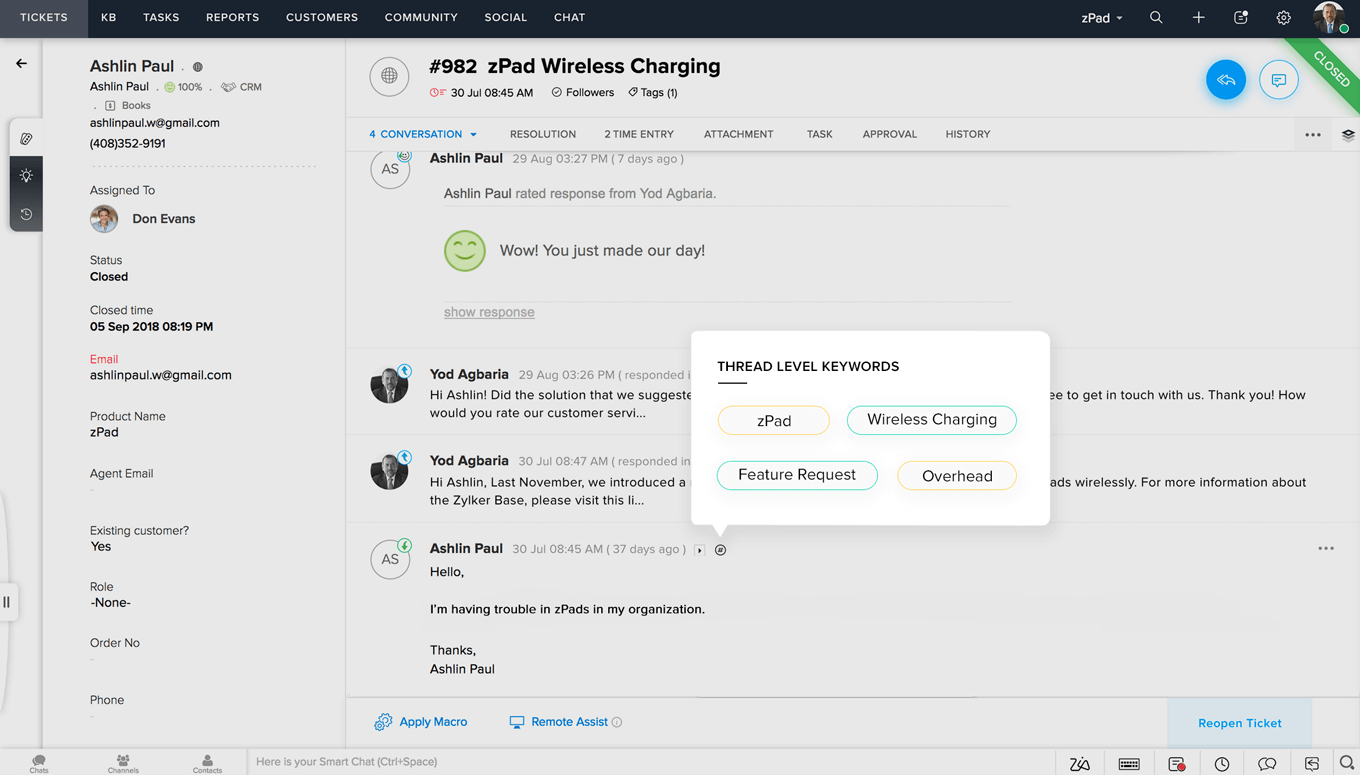
Zoho Desk는 비즈니스와 함께 성장해 나갈 플랫폼을 필요로 하는 소규모 고객 지원 팀에 적합합니다. 하지만 Zoho의 CRM은 규모에 관계없이 모든 업계의 비즈니스에 적합합니다. Zoho Desk는 다른 Zoho 제품과 쉽게 연동되기 때문에 사용자가 특히 유용하다고 느낍니다. 이미 Zoho 제품을 사용하고 계신다면 Zoho Desk를 구현하고 사용하는 것이 익숙하실 것입니다.
아울러, 조호 CRM을 사용하는 경우 데이터베이스를 Zoho Desk와 쉽게 동기화할 수 있습니다. 한 가지 명심할 점으로 Zoho는 소셜 미디어 연동, 데이터 분석 같은 새로운 기능을 지속적으로 추가하고 있어 제품이 어떻게 발전해 나가는지 주목해야 합니다. 매우 기본적이지만 Zoho Desk는 이메일 기반 IT 티켓 시스템, 개인 지식 관리 및 다국어 지원이 포함된 무료 플랜을 제공합니다.
요금제:
- Standard: $20 월/사용자당
- Professional: $35 월/사용자당
- Enterprise: $50 월/사용자당
무료 평가판: 15일
Zoho Desk Standard Plan의 기능
- 제안된 자동화
- Zoho CRM
- 지식 창고
- 티켓 관리 시스템
- 대화 수신함
- 브랜딩 맞춤화
- 표준 및 미리 채워진 보고서
- 다중 채널 지원
3. Freshdesk

Freshdesk는 중소기업을 위한 또 다른 옵션으로 저렴한 가격과 직관적인 인터페이스를 갖췄습니다. 다섯 가지 에디션을 제공하는데, 그 중 하나인 Sprout는 무료 플랜이며 나머지 Blossom, Garden, Estate, Forest는 유료입니다. 가장 비싼 플랜을 이용하시면 팀 대시보드, 소셜 시그널, 채팅봇과 같은 주요 기능을 사용할 수 있습니다.
또한 Freshworks Academy도 제공하여 상담사에게 새 시스템을 교육시켜야 하는 부담을 덜어줍니다. 하지만 저가 플랜을 선택할 경우 제공되는 기능이 다소 제한될 수 있습니다. 이메일 통합 티켓 관리 도구, 분석, 미리 준비된 답변, 자동화 및 지식창고 관리가 포함된 Freshdesk 무료 플랜을 통해 소프트웨어를 전체적으로 느껴보세요.
요금제:
- Growth: $15 월/사용자당
- Pro: $49 월/사용자당
- Elite: $79 월/사용자당
무료 평가판: 21일
Freshdesk Growth Plan의 기능
- 자동화
- 티켓 보기 사용자 지정
- 이메일 서버 사용자 지정
- 시간 추적
- 마켓플레이스 앱
- 이메일 티켓 라우팅
- 지식 창고
- 헬프 데스크 및 티켓 트렌드 보고서
4. HappyFox

HappyFox는 다양한 업계의 다양한 사이즈의 기업에 통합 티켓 관리 솔루션을 제공하는 클라우드 기반 CRM입니다. HappyFox 고객은 소규모 기업에서 대기업에 이르기까지 다양한 기업에 서비스를 제공합니다. HappyFox의 통합 티켓 관리 소프트웨어는 사용하기 쉽고 강력한 기능을 제공하지만,
하지만 뛰어난 기능에 비해 가격과 연동 면에서 뒤처집니다. 그리고 Zendesk, Freshdesk, Zoho Desk와는 달리 여타 수많은 툴이나 시스템과 연동되지 않습니다.
소프트웨어를 사전에 경험해 볼 수 있는 무료 플랜이나 무료 평가판이 없습니다. HappyFox는 유료로만 사용이 가능하며, 가격대는 사용자당 월 $39~$99로 다양합니다. 동급 최고의 통합 티켓 관리 도구를 최우선으로 생각하신다면, HappyFox를 고려해 볼 만합니다.
요금제:
- Mighty: $39 월/사용자당
- Fantastic: $59 월/사용자당
- Enterprise: $79 월/사용자당
- Enterprise Plus: $99 월/사용자당
무료 평가판: 15일
Mighty Plan의 기능
- SLA 관리
- 스마트 자동화
- 지식 창고
- 이메일 도메인 매핑 사용자 지정
- 기본 리포팅
5. WordPress Advanced Ticket System
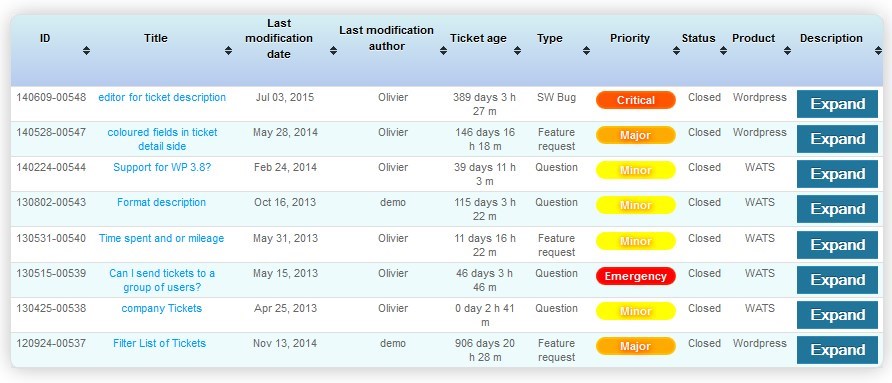
이미 워드프레스를 사용하고 있고 채널이 두 개 이하인 간단한 고객 서비스 업무라면 WordPress Advanced Ticket System 플러그인을 고려해 볼 가치가 있습니다. 오픈 소스 헬프 데스크 통합 티켓 소프트웨어로, 워드프레스를 기반으로 직접 구축되므로 매우 쉽게 연동할 수 있습니다. 또한, 사이트의 기본 단일 게시 템플릿을 사용해 티켓을 표시할 수 있어 사이트 운영 속도를 저하하지 않습니다.
물론 최고의 단순성에는 단점도 뒤따릅니다. 이 시스템은 소셜 미디어, 실시간 채팅, 블로그 댓글에서는 통합 티켓 관리를 바로 지원하지 않습니다. 따라서 더 크고, 더 복잡한 서비스를 운영하는 조직의 경우 이 통합 티켓 관리 시스템은 지나치게 기본적일 수 있습니다.
어느 쪽이든 Web-to-Email 기반 통합 티켓 관리가 포함된 무료 요금제를 통해 WATS를 경험해 볼 수 있습니다. 프리미엄 플랜의 경우 50유로의 연간 요금을 지불해야 하며, 이 글을 쓰는 시점에 미화로 환산 시 55.35달러입니다.
요금제:
- WATS Free
- WATS Premium: €50/년
무료 평가판: 없음
WATS Free의 기능
- 파일 첨부
- 미가공 통계
- 이메일 티켓 라우팅
6. Help Scout
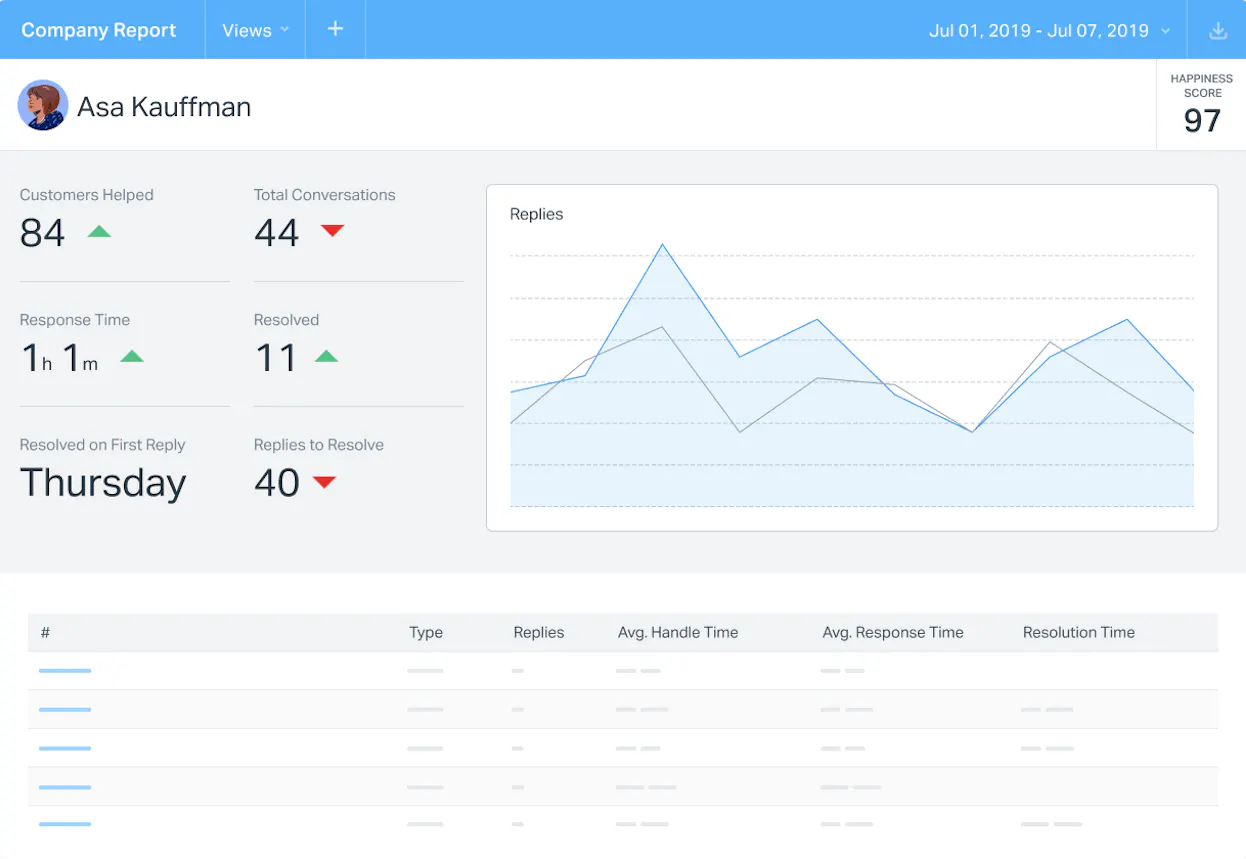
Help Scout 헬프 데스크 통합 티켓 관리 시스템은 HappyFox와 마찬가지로 모든 기능을 갖췄으며,
사용자가 500명 이상인 대규모 고객서비스팀을 지원할 수 있습니다. 기술 및 채용 산업의 다양한 현대적인 비즈니스를 고객으로 두고 있습니다. 하지만 강력하고 유연한 티켓 관리 도구가 필요한 소규모 팀에도 매우 적합합니다.
Help Scout는 통합 티켓 관리 시스템 외에도 탄탄한 리포팅 기능과 지식창고를 기본으로 제공합니다. 아울러, 강력한 API와 광범위한 연동 서비스 옵션을 통해 기존 고객 채널 및 데이터베이스에서 매끄럽게 작동합니다. 약정 전에 Help Scout를 테스트해보고 싶으시다면 15일 무료 평가판을 사용해보세요. 서비스 상담사가 Help Scout의 전체 기능에 액세스할 수 있습니다.
요금제:
- Standard: $20 월/사용자당
- Plus: $35 월/사용자당
- Company: $60 월/사용자당
무료 평가판: 15일
HelpScout Standard의 기능
- 규칙 기반 자동화
- 익스텐션 · 연동 서비스
- 웹사이트 실시간 채팅
- 맞춤형 보고서
- 티켓 라우팅 · 우선순위 지정
- 지식창고 콘텐츠 관리
- 다중 채널 커뮤니케이션
7. LiveAgent

LiveAgent는 실시간 타이핑 보기, 채팅 참여를 위한 웹사이트 모니터링, 채팅 가능 상담사를 바탕으로 한 전향적 채팅 초대 등의 기능으로 향상된 라이브 채팅을 제공합니다. 또한 다양한 채널에서 티켓을 수집하고 통합하는 받은 편지함을 범용으로 제공합니다.
LiveAgent는 워드프레스를 사용하는 소규모 지원팀에게 특히 적합하며, 많은 지원팀이 사용하는 대다수 인기 앱과 네이티브 연동 기능을 제공합니다. 무료 버전은 물론 상담사당 월 15~39달러를 지불하는 유료 버전도 있어 다양한 선택이 가능합니다. 무료 버전에는 통합 티켓 관리 도구, 고객 포털 및 포럼이 포함되어 있습니다. 하지만 기본 보고 기능, 7일간의 티켓 내역, 채팅 버튼 1개, 전화번호 1개, 이메일 주소 1개만 이용할 수 있습니다.
요금제:
- Ticket: $15 월/상담사당
- Ticket+Chat: $29 월/상담사당
- 모두 포함: $49 월/상담사당
무료 평가판: 14일
LiveAgent Ticket Plan의 기능
- 무제한 티켓 내역
- API 및 연동
- 헬프 포털 및 포럼
- 고급 리포팅
- 무제한 이메일 주소
- 고객 서비스
8. KB Support

KB 서포트 플러그인은 가볍게 작동하고 워드프레스 친화적인 또 다른 헬프 데스크 통합 티켓 관리 시스템입니다. WAPS 플러그인과 유사하게 KB Support는 상대적으로 소규모로 서비스를 운영하는 중소기업을 위해 설계되었습니다. 하만 가능한 연동 범위가 넓기 때문에 특히 WooCommerce 및/또는 WordPress를 사용하는 경우 기업이 성장함에 따라 KB Support에서 벗어날 수 있습니다.
플러그인은 웹 양식, 이메일, 상담사 권한, 사용자 지정 티켓 상태, 사전 설정된 응답 및 WooCommerce 연동 서비스를 통한 통합 티켓 관리를 지원합니다. 또한 Zapier를 통해 타 앱과도 쉽게 연동됩니다.
통합 티켓 관리 기능 외에도 사용자에게 셀프 서비스 옵션을 제공하는 데 사용할 수 있는 지식창고도 포함되어 있습니다.
로그인한 유저만 사용할 수 있도록 특정 문서를 제한할 수도 있습니다. KB Support는 WordPress 플러그인으로 무료로 제공되지만 지식창고 연동, 미리 준비된 답변, 사용자 지정 티켓 상태 및 기타 여러 주요 기능은 포함하지 않습니다.
요금제:
- Starter: 연간 $74
- Professional: $102
- Enterprise: $150
무료 평가판: 없음
Starter Plan의 기능
- 네이티브 자동화
- 이메일 티켓 관리
- WooCommerce 연동
- 추적 및 측정
- 티켓 라우팅
- 티켓 상태 사용자 지정
- FAQ 지원
- 고객 피드백
9. Vision Helpdesk

비전 헬프데스크는 모든 팀 규모와 업계에 맞춰 설계된 클라우드 기반 헬프 데스크 통합 티켓 관리 시스템입니다. 특히 Vision Helpdesk는 대규모 금융 및 정부 기관에 적합니다. 지원팀은 규칙 기반 기준으로 티켓 관리를 자동화하고 소셜미디어, 이메일, 실시간 채팅, 웹 포털, 통화에서 대화를 녹음할 수 있습니다.
상담사의 생산성을 지원하기 위한 방법으로, 기업이 상담사의 성과에 보상을 지급할 수 있는 게임화 기능도 제공합니다. 안드로이드, iOS, 윈도우 폰용 모바일 앱을 사용할 수 있지만, 대다수 사용자들은 모바일 앱의 성능 개선이 필요하다고 지적합니다. 직접 테스트해보고 싶다면 Vision Helpdesk의 무료 평가판(신용카드 불필요)을 30일 동안 사용해보세요.
요금제:
- Starter Help Desk: $12 월/사용자당
- Pro Help Desk: $20 월/사용자당
- Satellite Help Desk: $24 월/사용자당
- Pro Service Desk: $32 월/사용자당
- Enterprise Service Desk: $48 월/사용자당
무료 평가판: 30일
Starter Help Desk Plan의 기능
- 워크플로우
- 이메일 티켓 만들기
- 리포팅 · 애널리틱스
- 통합 티켓 관리
- 공유 수신함
- 최적화된 지식창고 콘텐츠
- 다중 채널 지원
10. HubSpot Service Hub
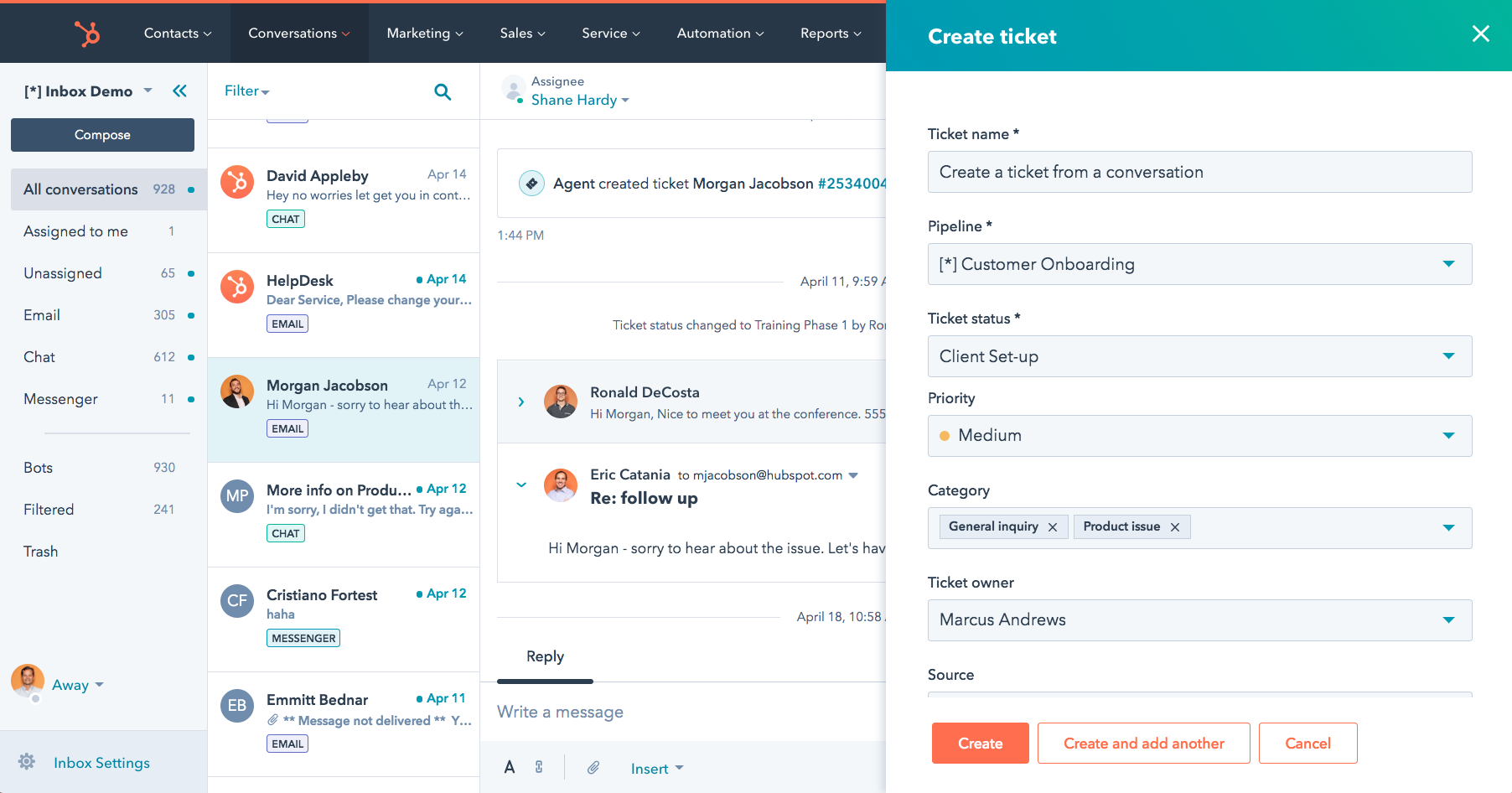
HubSpot은 서비스 허브 제품을 통해 강력한 통합 티켓 관리 시스템을 제공합니다. 서비스 허브는 폭넓은 헬프 데스크 기능을 제공할 뿐 아니라 상담사가 티켓의 우선순위를 정하고 워크플로우를 자동화하며 여러 서비스 채널에 걸쳐 개인화된 서비스를 제공할 수 있도록 지원합니다. HubSpot은 잘 맞춤화된 다양한 패키지를 보유하고 있기 때문에 거의 모든 업계의 모든 규모의 기업이 개별 니즈에 맞는 패키지를 찾을 수 있습니다.
CRM을 비롯해 HubSpot의 타 제품을 이미 사용하고 있다면, 간단하게 연동할 수 있습니다. 또한 HubSpot을 사용하고 있지 아니더라도 광범위한 연동 기능을 통해 통합 티켓 관리 시스템을 워크플로우에 쉽게 구현할 수 있습니다. HubSpot은 지원 티켓 시스템, 사용자 지정 필드, 공유 편지함, 보고, 미리 준비된 코드 조각 및 기타 CRM 기능이 포함된 제한된 무료 플랜을 제공합니다. 또는 Service Hub Professional 또는 Enterprise를 14일 동안 무료로 테스트해 보세요.
요금제:
- Service Hub Starter: $45 월/사용자 2명당, $23 월/추가 사용자 당
- Service Hub Professional: $360 월/사용자 5명당, $72 월/추가 사용자 당
- Service Hub Enterprise: $1200 월/사용자 10명당, $120 월/추가 사용자 당
무료 평가판: 14일
Service Hub Starter Plan의 기능
- API, SDK, 네이티브 연동
- 미리 준비된 공유 코드 조각
- 실시간 웹사이트 채팅
- 고급 리포팅
- 티켓 라우팅, 카테고리 분류, 태그 지정
- 대화 수신함
11. Front
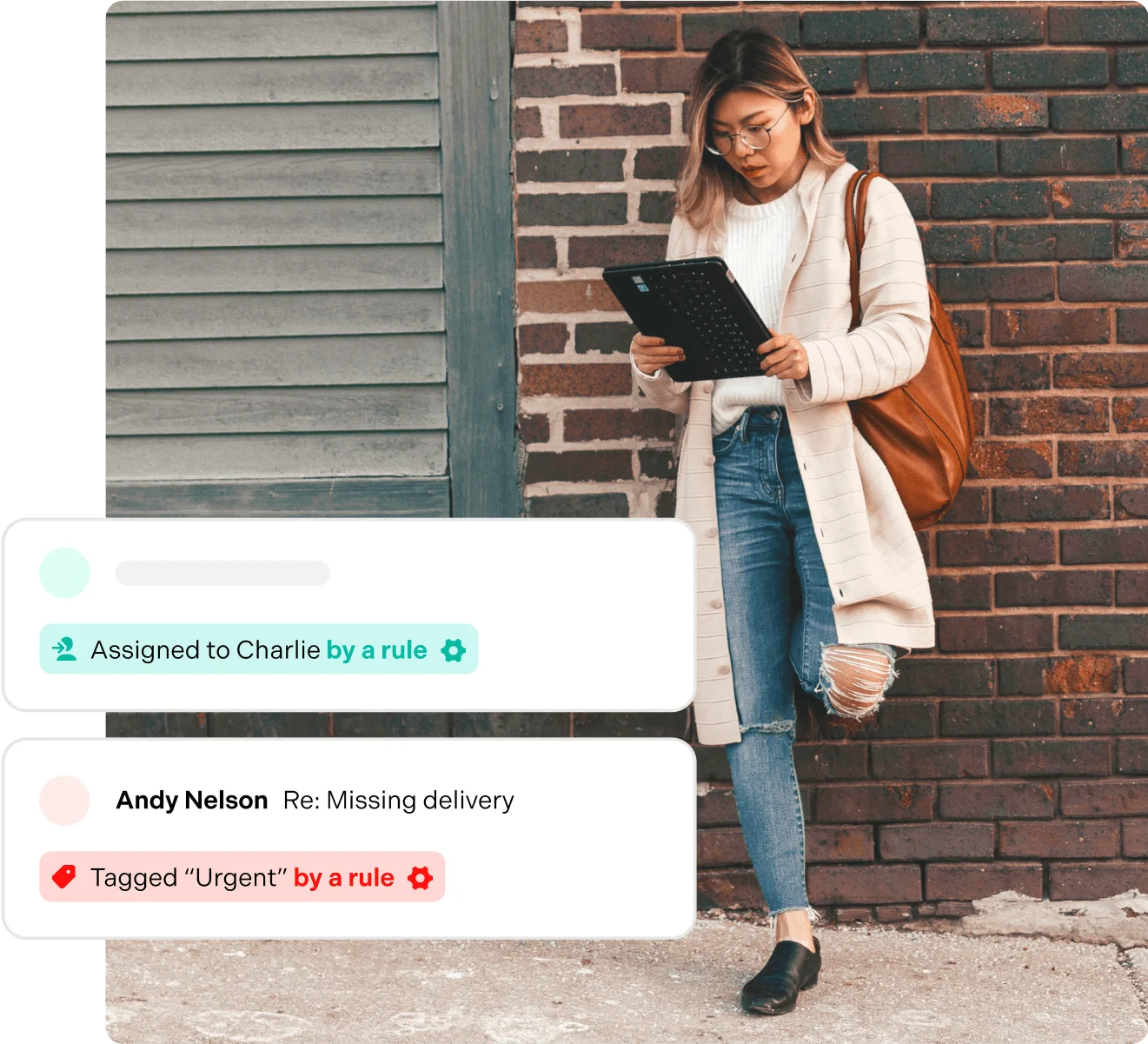
Front는 공유 이메일 수신함을 통해 전체 고객 서비스 팀을 연결합니다.
스타트업 인큐베이터, 전자 상거래 기업 및 기타 SaaS 비즈니스 등의 혁신적인 기업들은 Front를 사용해 고객 경험을 관리합니다. 이러한 기본 기능 외에도 서비스팀의 팀워크 문화를 조성하는 기능에 초점을 맞춥니다.
예를 들어, 한 상담사가 티켓을 선택한 후에도 다른 상담사가 여전히 해당 티켓의 진행 상황을 모니터링하여 투명성과 협업을 개선할 수 있습니다. 이와 마찬가지로, 프런트에서는 공유 보관함 도구를 통해 상담사가 고객에게 응답하기 전에 티켓을 함께 작업할 수 있습니다. 아울러 이메일, 채팅, 소셜미디어, SMS를 포함한 모든 채널의 이메일과 메시지에 통합 티켓 관리를 지원합니다.
Front는 무료 플랜이나 무료 평가판을 제공하지 않습니다.
요금제
- Starter: $19 per 월/사용자당(2명 이상부터 이용 가능)
- Prime: $49 월/사용자당(5명 이상부터 이용 가능)
- Enterprise 가격 미제시
무료 평가판: 없음
Starter 기능
- 이메일, 채팅, SMS 및 소셜 미디어 통합 티켓 관리
- 티켓 공동 작업 도구
- 제한된 연동 서비스
- 통합 티켓 관리 규칙 템플릿
- 사용자 최대 10명
12. AzureDesk
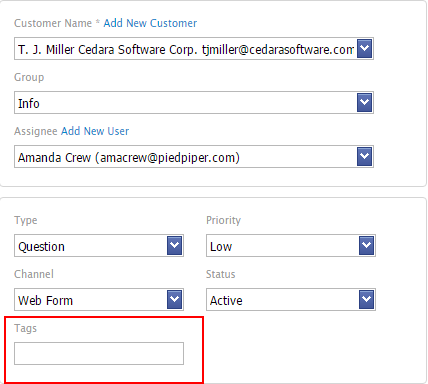
AzureDesk는 리포팅, 티켓 관리, 지식창고 관리, 이메일/티켓 변환 등과 같은 핵심 기능을 제공합니다. 즉, 대규모 고객 서비스 부서를 지원할 만한 충분한 역능을 갖춘 라이트 시스템입니다. 하지만 AzureDesk의 통합 티켓 관리 시스템은 중소기업의 니즈 또한 충족합니다.
타 제품과 다른 점으로는 통합 티켓 관리 시스템에서 이메일 주소를 무제한 사용할 수 있어 이메일을 티켓으로 손쉽게 변환할 수 있습니다.
또한 수많은 고객 서비스 연동을 지원하고 슬랙을 비롯한 인기 지원 앱과도 사전 연동을 지원하는 API를 갖춘 매우 유연한 소프트웨어입니다.
14일 무료 평가판을 통해 AzureDesk의 기능을 모두 경험해 보세요.
요금제
- AzureDesk Plus: $33 월/사용자당
무료 평가판: 14일
AzureDesk Plus Plan의 기능
- 스마트 자동화
- 티켓 태그
- 비공개 메모
- API · 앱 연동
- 실시간 채팅 위젯
- 상담사 서명
- 고급 리포팅
- 티켓 관리
- 공유 이메일 수신함
- 브랜드 맞춤화
- 지식 콘텐츠 관리
- 옴니채널 지원
13. SupportBee
심플하고 직관적인 통합 티켓 관리 시스템으로 설계된 서포트비는 빠른 실행이 필요한 소규모 지원 팀을 위해 설계되었습니다.
통합형 이메일 수신함과 고객 평가를 포함한 탄탄한 기본 기능을 제공하고, 플랜에는 무제한 티켓과 이메일 수신함이 포함되어 있어 필요에 따라 손쉽게 확장할 수 있습니다.
심플함이라는 장점이 있는 반면, 맞춤화 기능이 다소 부족한 단점도 있습니다. 따라서 맞춤형 서비스와 확장 가능한 툴을 제공하는 솔루션이 필요한 경우에는 부적합합니다. 확신이 들지 않는다면 14일 동안 Startup이나 Enterprise 플랜을 무료로 테스트해 보세요.
요금제:
- Startup: $13 월/사용자당
- Enterprise: $17 월/사용자당
무료 평가판: 14일
SupportBee Startup Plan의 기능
- 공유 수신함
- 미리 준비된 스니펫
- 기본 연동 서비스
- 지식 창고
- 고객 만족도 평점
- 단일 팀
- 2단계 인증
요금제:
Startup: $13 월/사용자당
Enterprise: $17 월/사용자당
14. Awesome Support
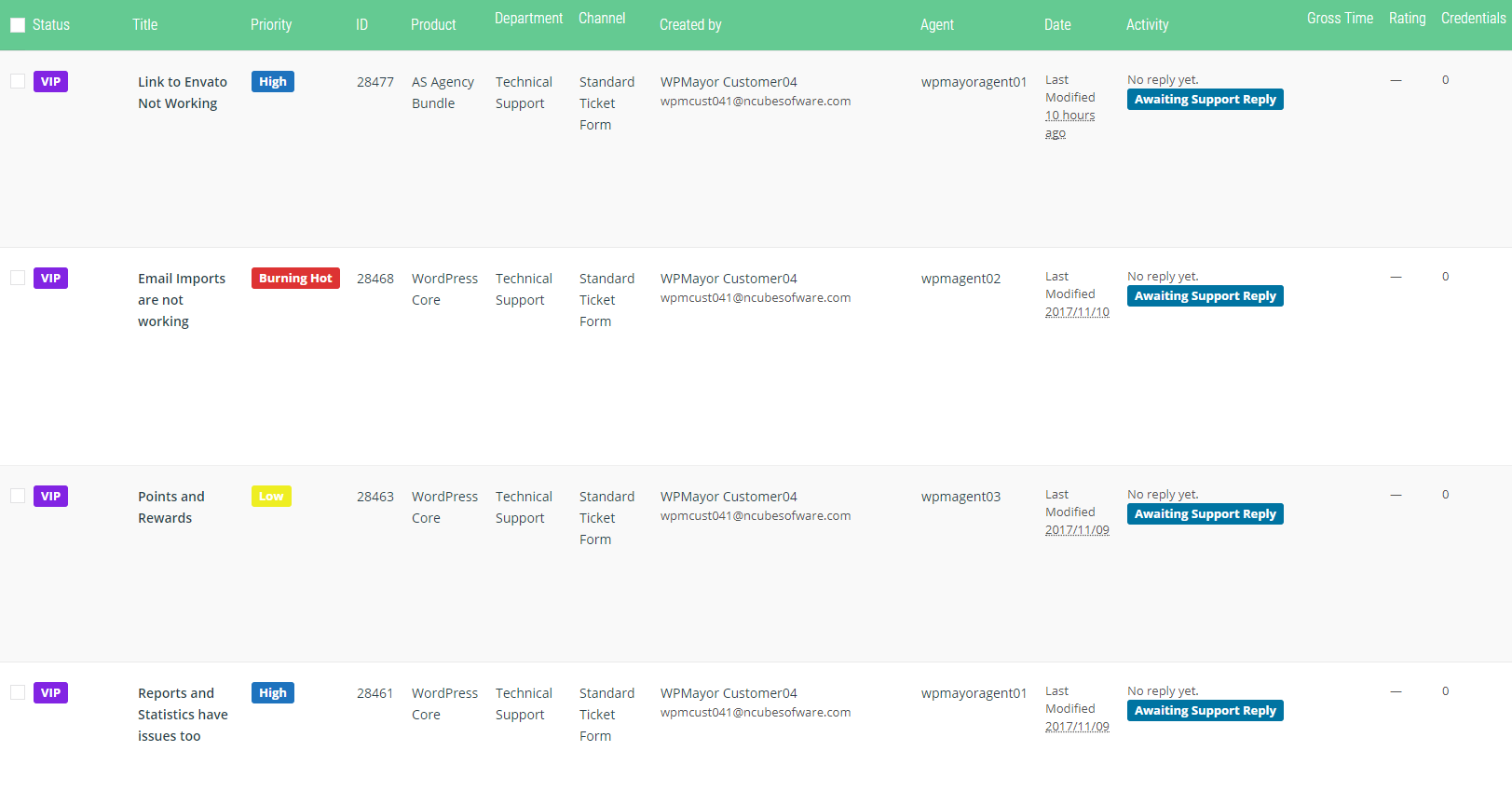
Awesome Support는 워드프레스를 위한 최고 인기 고객 지원 통합 티켓 관리 시스템 중 하나로, 무료 버전은 티켓, 상담사, 사용자, 제품, 부서를 무제한으로 허용합니다. 간단한 고객 지원을 위한 좋은 기본 바탕이지만, 고급 기능이 필요하면 업그레이드할 수도 있습니다. 최상위 플랜은 서비스수준협약(SLA), 심층 리포팅, 자동화를 지원합니다.
설치하기 매우 쉬운 반면, 대부분 지원 팀의 니즈를 충족할 만큼 기능이 강력하지는 않습니다. 따라서 웹사이트를 유일한 채널로 사용하는 지원 팀이 아니라면 다소 부족할 수 있습니다. 하지만 대규모 서비스를 운영하는 기업의 경우, Awesome Support의 유료 플랜을 통해 완전한 통합 티켓 관리 시스템 솔루션에서 기대할 수 있는 모든 기능을 제공받을 수있습니다.
요금제:
- Starter: $149/년
- Pro: $229/년
- Enterprise: $289/년
- Agency: $409/년
무료 평가판: 없음
Awesome Support Standard의 기능
- 미리 준비된 답변
- 무제한 티켓 내역
- 무제한 상담사 및 티켓
- 이메일 지원
- 자주 묻는 질문
- Mailchimp 연동
15. TeamSupport

TeamSupport는 B2B 기술 고객에게 서비스를 제공하는 기업의 니즈를 충족하도록 설계된 고객 지원 통합 티켓 관리 소프트웨어 솔루션입니다. TeamSupport의 리포팅 기능은 통합 티켓 관리 소프트웨어뿐 아니라 근본 원인 분석을 통해 티켓 양을 최소화하는 데 초점을 맞춥니다. 그 외에도 외부·내부 지식창고 기능과 고객 포럼을 제공합니다.
TeamSupport는 맞춤화 기능이 상당히 뛰어납니다. 예를 들어, 원하는 필드로 기본 티켓 관리 페이지를 만들 수 있고, 고객의 문의 내용과 관련된 문서를 자동으로 표시하는 제안과 같은 기능을 통해 상담사의 서비스 제공을 개선하는 데 초점을 맞춥니다. TeamSupport는 무료 플랜이나 무료 평가판을 제공하지 않습니다.
요금제:
- Essential: $49 월/사용자당
- Success: $59 월/사용자당
- Professional: $79 월/사용자당
- Enterprise: $99 월/사용자당
- TeamSupport CS Platform: $149 월/사용자당
무료 평가판: 없음
Team Support Essential의 기능
- 티켓 자동화 · 워크플로우
- 제3사 연동 서비스 · API
- 실시간 채팅
- 리포팅
- 맞춤형 티켓 관리
- 맞춤형 브랜딩
- 공유 수신함
- 고객 데이터베이스
- 지식 창고 관리
- 옴니채널 서비스
상위 15개 통합 티켓 관리 도구 비교 차트
| 소프트웨어 | 시작가(월/사용자당) | 무료 평가판 또는 무료 플랜 | 핵심 기능 |
|---|---|---|---|
Zendesk | $55 |
| |
Zoho Desk | $20 |
| |
Freshdesk | $15 |
| |
HappyFox | $39 | 해당 사항 없음 |
|
Wordpress Advanced Ticket System | 무료 | 무료 플랜 |
|
Help Scout | $20 | 무료 평가판 15일간 |
|
LiveAgent | $15 |
| |
KB Support | $74/년 |
| |
Vision Helpdesk | $12 |
| |
HubSpot Service Hub | $45 |
| |
Front | $19 | 해당 사항 없음 |
|
AzureDesk | $33 |
| |
SupportBee | $13 |
| |
Awesome Support | $149 | 무료 플랜 |
|
TeamSupport | $49 | 해당 사항 없음 |
|
최고의 통합 티켓 관리 소프트웨어를 선택하는 방법
IT 전문 인력이 이메일을 분류하거나 누가 어떤 티켓에 응답했는지 파악하는 데 모든 시간을 할애하고 있다면, 지금이야말로 변화가 필요합니다. 소프트웨어 중 통합 티켓 관리 소프트웨어는 고객지원팀이 가장 많이 사용하는 도구 중 하나이므로 시중에 나와 있는 수많은 옵션 중에서 선택하는 것은 중요한 결정입니다.
다음은 결정을 내리기 위해 본인과 팀원에게 물어야 할 여섯 가지 질문과 답변입니다.
Zendesk 통합 티켓 관리 시스템을 무료로 체험해 보세요
원활한 의사소통은 여러분과 팀원들에게 머나먼 희망 사항만은 아닙니다. Zendesk의 옴니채널 티켓 시스템을 사용하면 더 많은 고객에게 도달하고 조직 내 의사소통의 격차도 해소할 수 있습니다. 개방형 CRM 플랫폼인 Zendesk Sunshine을 사용하면 고객의 모든 데이터가 하나로 연결되어 상담사가 실시간 채팅 소프트웨어를 통해 여러 채널에서 고객에게 응답하는 데 필요한 전후상황을 빠짐없이 파악할 수 있습니다. 아울러 고객 서비스 분석 보고 기능으로 상담사의 작업에 대한 상세한 인사이트를 얻을 수 있어 팀원과 고객 모두를 위해 워크플로우를 더욱 원활하게 만들 수 있습니다. 모두에게 윈윈이죠.
더 많은 지식과 정보가 이곳에
지원 티켓 시스템은 우수한 고객 서비스의 꿈을 실현해 드립니다. 무한한 가능성에 대해 자세히 알아보세요.
